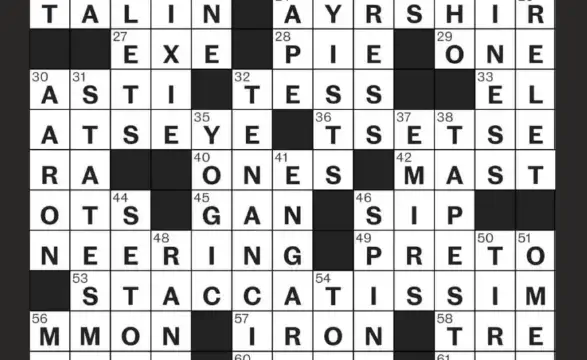Nyt Stories, Goads on Nyt. You may be informed about this if you read the newspaper, especially the New York Times, very often. This spiritual hint used by journalists for the interviewee response conduction or leads the interviewee thinking towards some point is called God say. From cryptic crossword addicts to veteran wordplay masters, they have served as the staple source material for generations of puzzlers through the wondrous workings of their enigmatic riddles. One such mystery that has puzzle solvers captivated is the Goads on Nyt.
Comprehending Goads on Nyt
“Goads” are the brief remarks that follow New York Times articles, allowing readers to react and discuss the content immediately. Originally launched in 2018, the goal of Goads is to encourage participation in the community and thoughtful online discussion around Times journalism.
As a reader, you may view all of the Goads for that specific article by scrolling to the bottom of the page. Which Goads are featured at the top are determined by The Times based on which are the most insightful and representative. Readers can then vote for the Goads they think are most valuable, causing the best remarks to rise to the top.
The History of the Crossword
Long ago, newspaper crosswords made their debut in 1913 in the New York World Newspaper. As demand grew, other newspapers followed suit. In 1942, “The New York Times” printed its first complete crossword puzzle, which was quickly embraced by avid and culturally aware solvers for its witty and literary clues.
The mystery of NYT’s puzzles is both alluring and daunting. They provide a starting point but leave the exact journey uncertain. Are they prompting action or pushing towards a solution? Perhaps the editor is toying with words, challenging our grasp of cryptic synonyms.
Which Wordplay Techniques Are Used?
Crossword creators employ diverse wordplay tactics, including puns essential for NYT’s “goads.” Understanding these strategies is crucial for conquering challenging puzzles.
- A pun is a wordplay device that creates a rhetorical or comedic effect by combining phrases with similar meanings.
- Using homophones, which are similar-sounding words with different meanings, is another wordplay strategy.
- Anagrams, which require rearranging letters to generate new words, and double meanings, which need solvers to consider a variety of possible interpretations, further raise the difficulty level of the challenge.
Techniques for Mastering Goads on NYT
Combining creative problem-solving methods with strategic thinking is necessary for navigating crossword puzzles. Here are some tips for deciphering puzzles like Goads on NYT:
1. Synonym Knowledge
Crossword clues allow for various interpretations. Considering “Goads” on NYT, alternatives like encouragement or urges should be considered.
2. Why it’s Vital to Consider Context
Consider the publishing date and the history of the puzzle. Customizing clues to match specific themes or events is conceivable, and being aware of this backdrop may offer crucial cues for potential solutions.
3. Cross-Reference
Look over the surrounding hints, the total amount of letters, and the overall theme of the puzzle. Look for trends, correlations, and other data that could point to a specific solution for goads on Nyt.
4. Making Use of Internet Resources
Online forums and crossword puzzle databases can be highly beneficial resources. Enthusiasts of crosswords often provide discussions, answers, and different strategies, promoting a cooperative approach to problem-solving.
5. Exercise caution
Examine common NYT tactics including puns, anagrams, homophones, and double meanings. Your ability to comprehend information will increase if you can precisely identify these patterns.
6. Employ trial-and-error
Don’t hesitate to try different answers in crossword puzzles. Solvers often test multiple solutions through trial and error. Look beyond literal meanings and consider puns, idioms, pop culture, and historical references.
7. Have a Rest
There are instances when waiting around yields better results than shoving things into place. Allow the tip to sit, allow your mind to wander, and see if the solution emerges unexpectedly. Seeing the puzzle through fresh eyes may bring connections and concepts to light that were previously overlooked.
Goads’ Future on NYT Crosswords
“Goad” clues have been a staple in The New York Times crossword since its inception, but their future popularity is uncertain. As puzzle designers aim for fresher, more relevant clues, references to farming tools like goads may become less common, especially in puzzles for casual solvers.
The future of “goads” in NYT puzzles is uncertain, but they may endure for loyal solvers who cherish their wit and nostalgia. Also, Yet, they could lose appeal to casual solvers, who prefer contemporary entries. However, maintaining a balance between freshness and complexity, NYT goads continue to serve a diverse audience.
Final Thoughts
Additionally, The NYT’s Goads on Nyt section offers a fun selection of games, puzzles, and brainteasers to hone your skills and extend your viewpoint. Whether you enjoy the wordplay of crosswords, the logic of Sudoku, or the visual-spatial reasoning of kakuro, the NYT Goad section has something to offer everyone. Solving these kinds of mental problems can help you pass the time while you’re not working, ease stress, and keep your mind engaged as you age.
FAQ’s
Q1. Are Goads unique to the crossword puzzles in the New York Times?
1. Goads aren’t just found in NYT puzzles but are often linked with the tough clues in this renowned daily.
Q2. How can I get better at deciphering difficult crossword clues and Goads?
1. For tough crosswords, develop a strategy, practice regularly, and seek tips from experienced solvers.
Q3. Has there ever been a dispute over Goads in crossword puzzles?
1. Disputes over tricky clues like “goads” often stem from interpretation, culture, or difficulty perceptions.
Q4. Does completing crossword puzzles improve mental health?
1. Solving tough crosswords, like those with tricky hints such as “Goads,” boosts memory, sharpens thinking, and improves problem-solving.
Q5. Where can I locate websites where I may solve crossword puzzles and interact with other enthusiasts?
1. Discover crossword puzzle websites and apps for a fun and engaging experience with a global community of enthusiasts.
